Comprehensive Report on Business Communication Analysis
VerifiedAdded on 2020/12/29
|13
|2476
|101
Report
AI Summary
This report provides a comprehensive overview of business communication, exploring various models such as Aristotle's, Lasswell's, and Shannon and Weaver's models. It details different communication systems, including optical, radio, duplex, and tactical communication. The report also examines essential communication methods like face-to-face, email, teleconferencing, and video conferencing, while emphasizing the importance of simplicity, clarity, brevity, and planning for effective communication. Furthermore, it addresses potential barriers such as jargon, emotional barriers, and differing perceptions, offering solutions like clear communication, understanding receiver needs, and ensuring feedback. The report concludes with a discussion on oral communication, including formal and informal types, along with examples of email, CV, and leaflet formats for business applications.
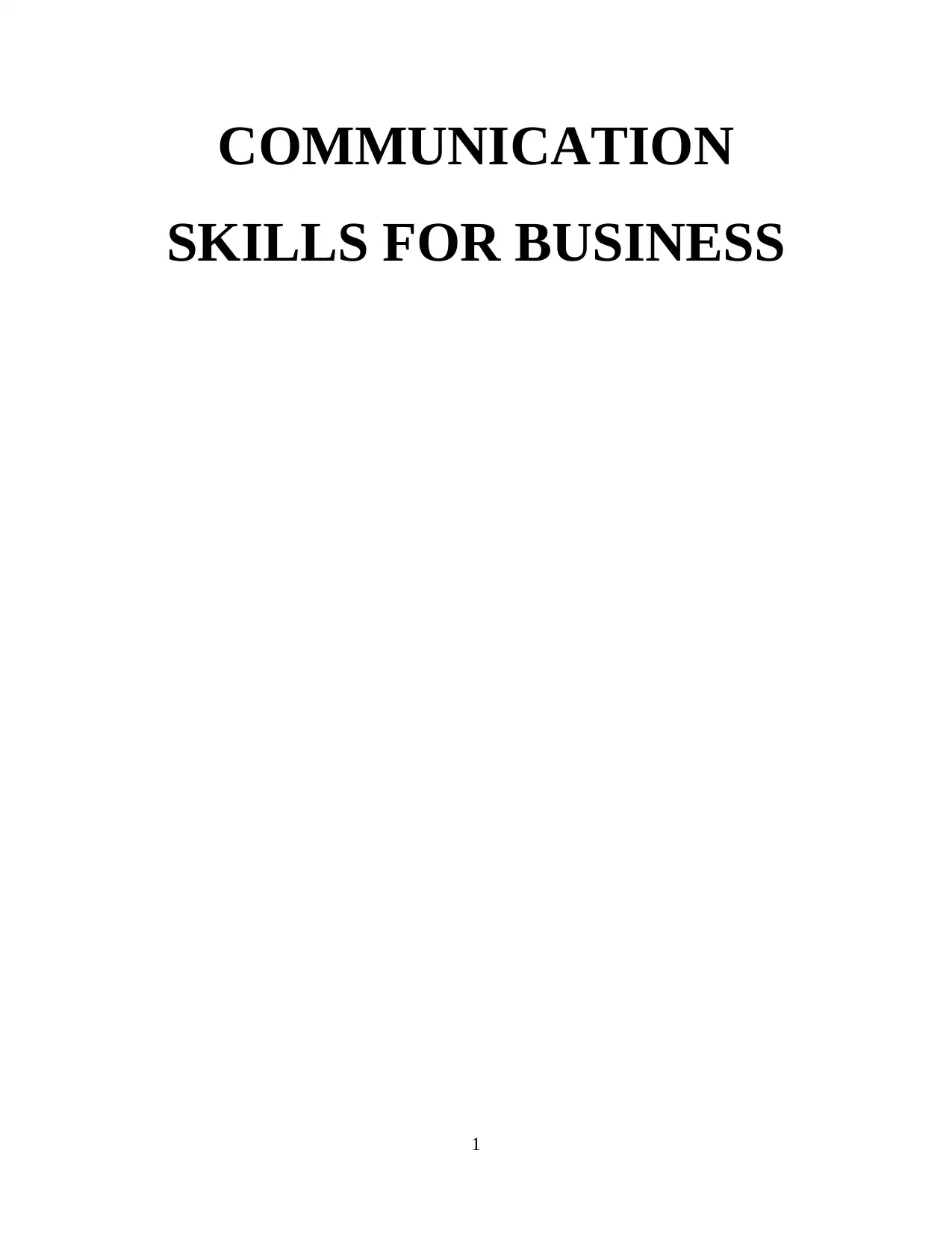
COMMUNICATION
SKILLS FOR BUSINESS
1
SKILLS FOR BUSINESS
1
Paraphrase This Document
Need a fresh take? Get an instant paraphrase of this document with our AI Paraphraser
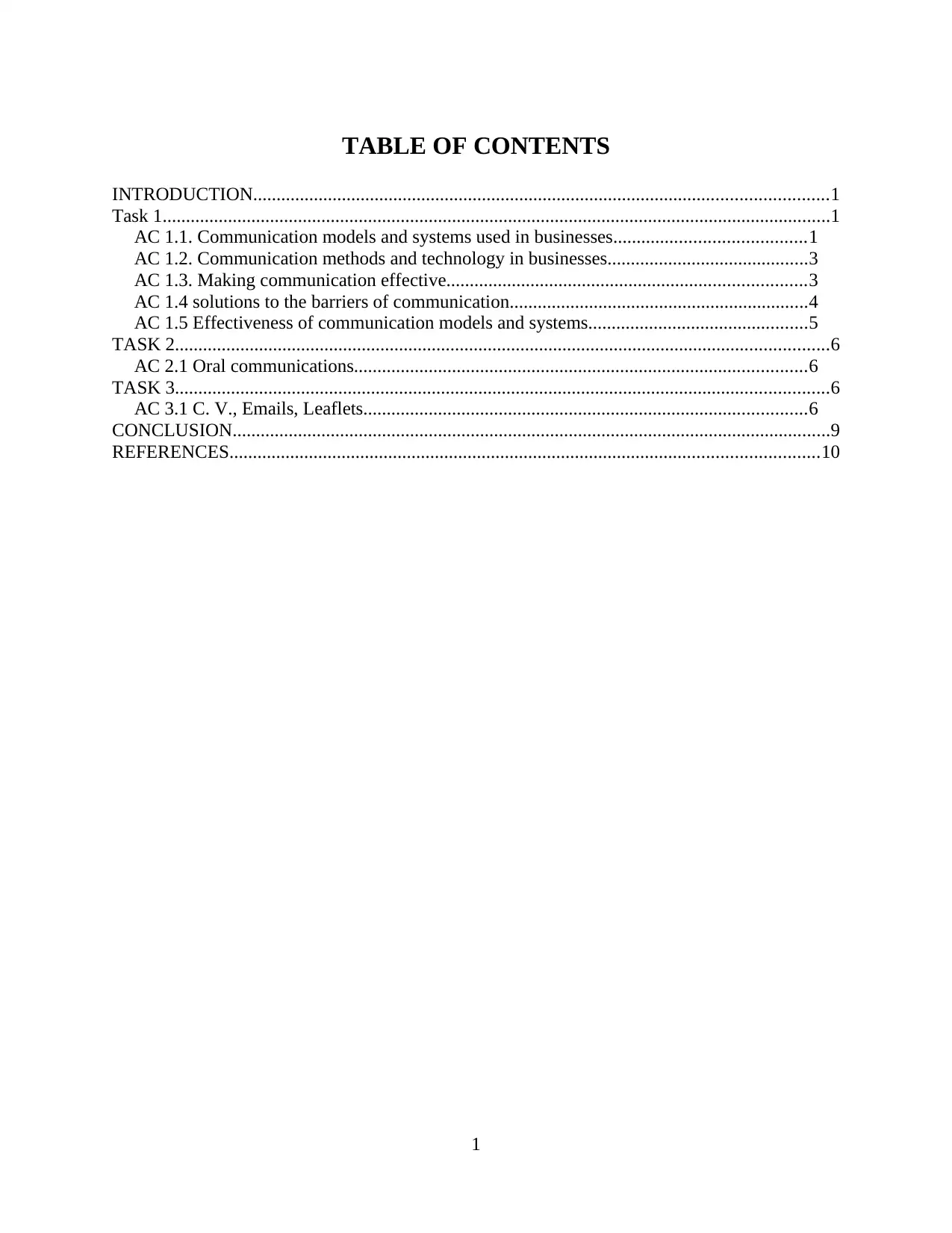
TABLE OF CONTENTS
INTRODUCTION...........................................................................................................................1
Task 1...............................................................................................................................................1
AC 1.1. Communication models and systems used in businesses.........................................1
AC 1.2. Communication methods and technology in businesses...........................................3
AC 1.3. Making communication effective.............................................................................3
AC 1.4 solutions to the barriers of communication................................................................4
AC 1.5 Effectiveness of communication models and systems...............................................5
TASK 2............................................................................................................................................6
AC 2.1 Oral communications.................................................................................................6
TASK 3............................................................................................................................................6
AC 3.1 C. V., Emails, Leaflets...............................................................................................6
CONCLUSION................................................................................................................................9
REFERENCES..............................................................................................................................10
1
INTRODUCTION...........................................................................................................................1
Task 1...............................................................................................................................................1
AC 1.1. Communication models and systems used in businesses.........................................1
AC 1.2. Communication methods and technology in businesses...........................................3
AC 1.3. Making communication effective.............................................................................3
AC 1.4 solutions to the barriers of communication................................................................4
AC 1.5 Effectiveness of communication models and systems...............................................5
TASK 2............................................................................................................................................6
AC 2.1 Oral communications.................................................................................................6
TASK 3............................................................................................................................................6
AC 3.1 C. V., Emails, Leaflets...............................................................................................6
CONCLUSION................................................................................................................................9
REFERENCES..............................................................................................................................10
1
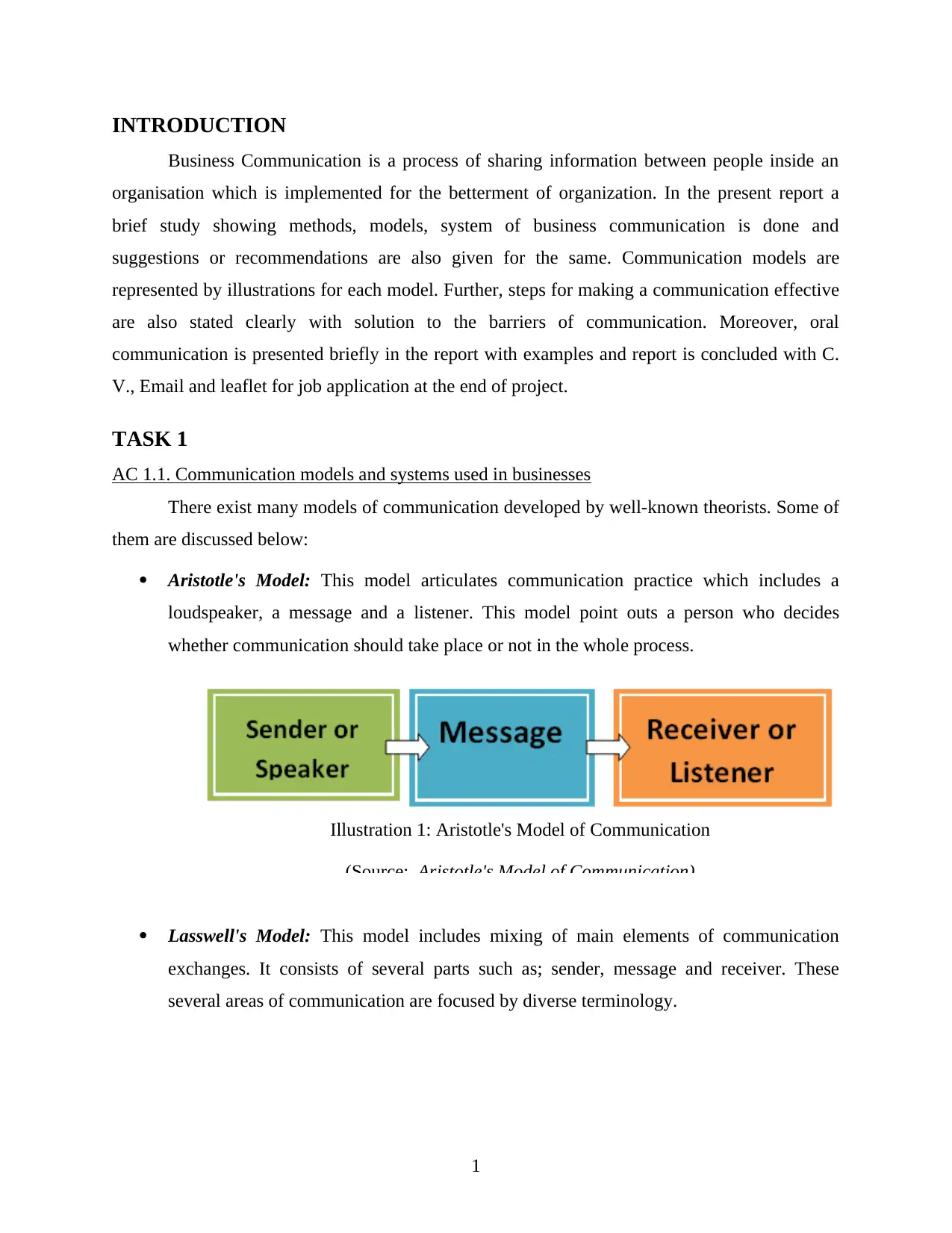
INTRODUCTION
Business Communication is a process of sharing information between people inside an
organisation which is implemented for the betterment of organization. In the present report a
brief study showing methods, models, system of business communication is done and
suggestions or recommendations are also given for the same. Communication models are
represented by illustrations for each model. Further, steps for making a communication effective
are also stated clearly with solution to the barriers of communication. Moreover, oral
communication is presented briefly in the report with examples and report is concluded with C.
V., Email and leaflet for job application at the end of project.
TASK 1
AC 1.1. Communication models and systems used in businesses
There exist many models of communication developed by well-known theorists. Some of
them are discussed below:
Aristotle's Model: This model articulates communication practice which includes a
loudspeaker, a message and a listener. This model point outs a person who decides
whether communication should take place or not in the whole process.
Lasswell's Model: This model includes mixing of main elements of communication
exchanges. It consists of several parts such as; sender, message and receiver. These
several areas of communication are focused by diverse terminology.
1
Illustration 1: Aristotle's Model of Communication
(Source: Aristotle's Model of Communication)
Business Communication is a process of sharing information between people inside an
organisation which is implemented for the betterment of organization. In the present report a
brief study showing methods, models, system of business communication is done and
suggestions or recommendations are also given for the same. Communication models are
represented by illustrations for each model. Further, steps for making a communication effective
are also stated clearly with solution to the barriers of communication. Moreover, oral
communication is presented briefly in the report with examples and report is concluded with C.
V., Email and leaflet for job application at the end of project.
TASK 1
AC 1.1. Communication models and systems used in businesses
There exist many models of communication developed by well-known theorists. Some of
them are discussed below:
Aristotle's Model: This model articulates communication practice which includes a
loudspeaker, a message and a listener. This model point outs a person who decides
whether communication should take place or not in the whole process.
Lasswell's Model: This model includes mixing of main elements of communication
exchanges. It consists of several parts such as; sender, message and receiver. These
several areas of communication are focused by diverse terminology.
1
Illustration 1: Aristotle's Model of Communication
(Source: Aristotle's Model of Communication)
⊘ This is a preview!⊘
Do you want full access?
Subscribe today to unlock all pages.

Trusted by 1+ million students worldwide
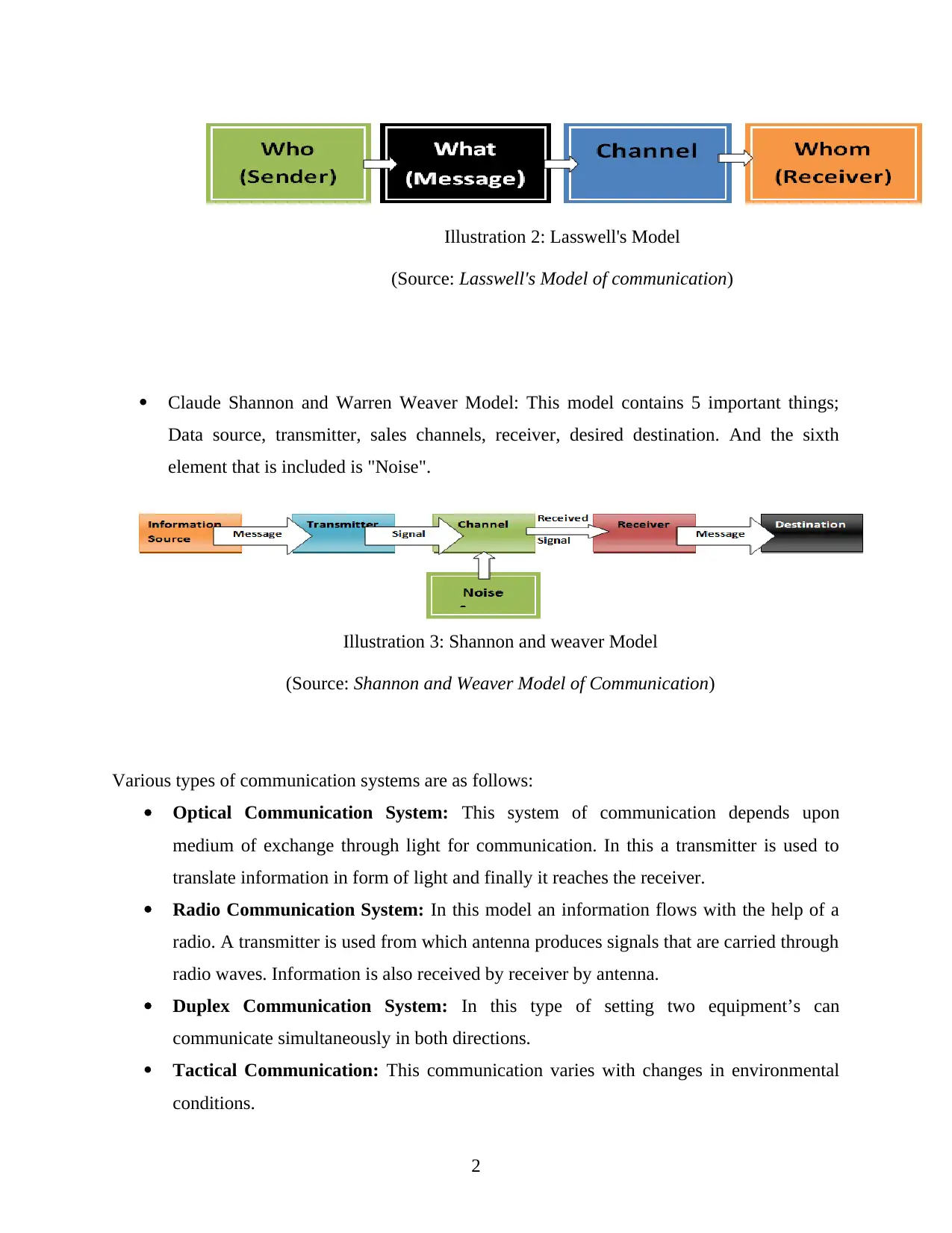
Claude Shannon and Warren Weaver Model: This model contains 5 important things;
Data source, transmitter, sales channels, receiver, desired destination. And the sixth
element that is included is "Noise".
Various types of communication systems are as follows:
Optical Communication System: This system of communication depends upon
medium of exchange through light for communication. In this a transmitter is used to
translate information in form of light and finally it reaches the receiver.
Radio Communication System: In this model an information flows with the help of a
radio. A transmitter is used from which antenna produces signals that are carried through
radio waves. Information is also received by receiver by antenna.
Duplex Communication System: In this type of setting two equipment’s can
communicate simultaneously in both directions.
Tactical Communication: This communication varies with changes in environmental
conditions.
2
Illustration 2: Lasswell's Model
(Source: Lasswell's Model of communication)
Illustration 3: Shannon and weaver Model
(Source: Shannon and Weaver Model of Communication)
Data source, transmitter, sales channels, receiver, desired destination. And the sixth
element that is included is "Noise".
Various types of communication systems are as follows:
Optical Communication System: This system of communication depends upon
medium of exchange through light for communication. In this a transmitter is used to
translate information in form of light and finally it reaches the receiver.
Radio Communication System: In this model an information flows with the help of a
radio. A transmitter is used from which antenna produces signals that are carried through
radio waves. Information is also received by receiver by antenna.
Duplex Communication System: In this type of setting two equipment’s can
communicate simultaneously in both directions.
Tactical Communication: This communication varies with changes in environmental
conditions.
2
Illustration 2: Lasswell's Model
(Source: Lasswell's Model of communication)
Illustration 3: Shannon and weaver Model
(Source: Shannon and Weaver Model of Communication)
Paraphrase This Document
Need a fresh take? Get an instant paraphrase of this document with our AI Paraphraser
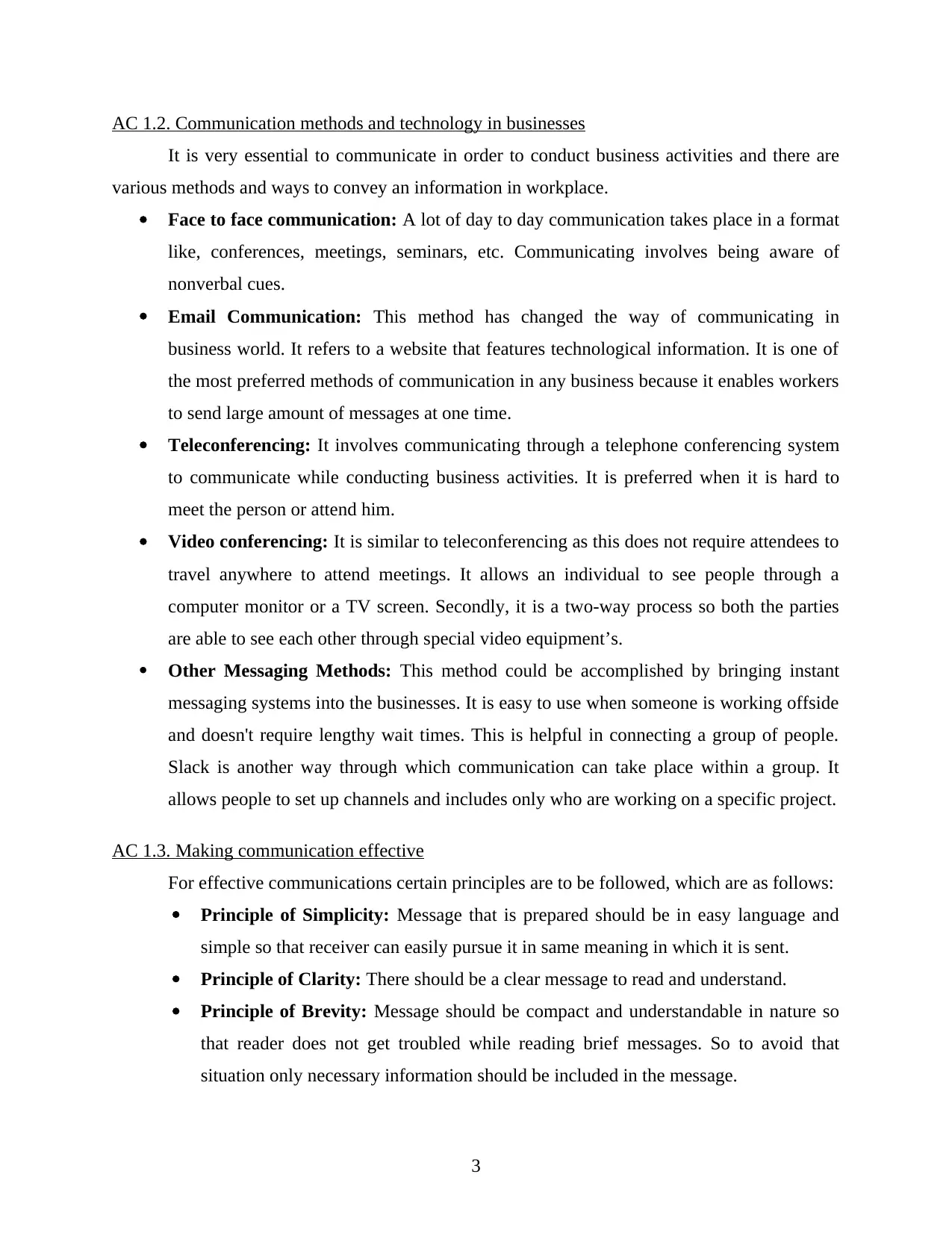
AC 1.2. Communication methods and technology in businesses
It is very essential to communicate in order to conduct business activities and there are
various methods and ways to convey an information in workplace.
Face to face communication: A lot of day to day communication takes place in a format
like, conferences, meetings, seminars, etc. Communicating involves being aware of
nonverbal cues.
Email Communication: This method has changed the way of communicating in
business world. It refers to a website that features technological information. It is one of
the most preferred methods of communication in any business because it enables workers
to send large amount of messages at one time.
Teleconferencing: It involves communicating through a telephone conferencing system
to communicate while conducting business activities. It is preferred when it is hard to
meet the person or attend him.
Video conferencing: It is similar to teleconferencing as this does not require attendees to
travel anywhere to attend meetings. It allows an individual to see people through a
computer monitor or a TV screen. Secondly, it is a two-way process so both the parties
are able to see each other through special video equipment’s.
Other Messaging Methods: This method could be accomplished by bringing instant
messaging systems into the businesses. It is easy to use when someone is working offside
and doesn't require lengthy wait times. This is helpful in connecting a group of people.
Slack is another way through which communication can take place within a group. It
allows people to set up channels and includes only who are working on a specific project.
AC 1.3. Making communication effective
For effective communications certain principles are to be followed, which are as follows:
Principle of Simplicity: Message that is prepared should be in easy language and
simple so that receiver can easily pursue it in same meaning in which it is sent.
Principle of Clarity: There should be a clear message to read and understand.
Principle of Brevity: Message should be compact and understandable in nature so
that reader does not get troubled while reading brief messages. So to avoid that
situation only necessary information should be included in the message.
3
It is very essential to communicate in order to conduct business activities and there are
various methods and ways to convey an information in workplace.
Face to face communication: A lot of day to day communication takes place in a format
like, conferences, meetings, seminars, etc. Communicating involves being aware of
nonverbal cues.
Email Communication: This method has changed the way of communicating in
business world. It refers to a website that features technological information. It is one of
the most preferred methods of communication in any business because it enables workers
to send large amount of messages at one time.
Teleconferencing: It involves communicating through a telephone conferencing system
to communicate while conducting business activities. It is preferred when it is hard to
meet the person or attend him.
Video conferencing: It is similar to teleconferencing as this does not require attendees to
travel anywhere to attend meetings. It allows an individual to see people through a
computer monitor or a TV screen. Secondly, it is a two-way process so both the parties
are able to see each other through special video equipment’s.
Other Messaging Methods: This method could be accomplished by bringing instant
messaging systems into the businesses. It is easy to use when someone is working offside
and doesn't require lengthy wait times. This is helpful in connecting a group of people.
Slack is another way through which communication can take place within a group. It
allows people to set up channels and includes only who are working on a specific project.
AC 1.3. Making communication effective
For effective communications certain principles are to be followed, which are as follows:
Principle of Simplicity: Message that is prepared should be in easy language and
simple so that receiver can easily pursue it in same meaning in which it is sent.
Principle of Clarity: There should be a clear message to read and understand.
Principle of Brevity: Message should be compact and understandable in nature so
that reader does not get troubled while reading brief messages. So to avoid that
situation only necessary information should be included in the message.
3
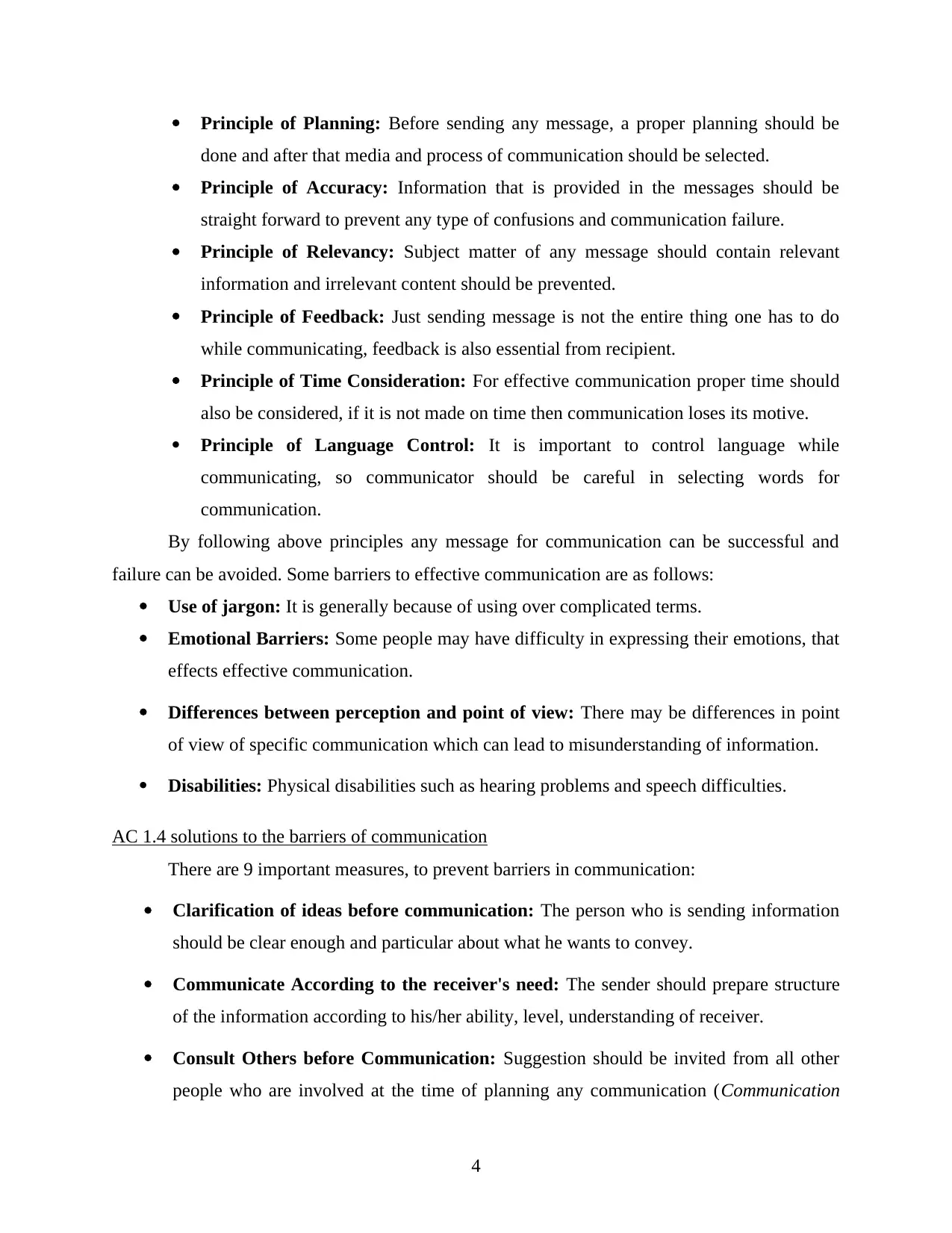
Principle of Planning: Before sending any message, a proper planning should be
done and after that media and process of communication should be selected.
Principle of Accuracy: Information that is provided in the messages should be
straight forward to prevent any type of confusions and communication failure.
Principle of Relevancy: Subject matter of any message should contain relevant
information and irrelevant content should be prevented.
Principle of Feedback: Just sending message is not the entire thing one has to do
while communicating, feedback is also essential from recipient.
Principle of Time Consideration: For effective communication proper time should
also be considered, if it is not made on time then communication loses its motive.
Principle of Language Control: It is important to control language while
communicating, so communicator should be careful in selecting words for
communication.
By following above principles any message for communication can be successful and
failure can be avoided. Some barriers to effective communication are as follows:
Use of jargon: It is generally because of using over complicated terms.
Emotional Barriers: Some people may have difficulty in expressing their emotions, that
effects effective communication.
Differences between perception and point of view: There may be differences in point
of view of specific communication which can lead to misunderstanding of information.
Disabilities: Physical disabilities such as hearing problems and speech difficulties.
AC 1.4 solutions to the barriers of communication
There are 9 important measures, to prevent barriers in communication:
Clarification of ideas before communication: The person who is sending information
should be clear enough and particular about what he wants to convey.
Communicate According to the receiver's need: The sender should prepare structure
of the information according to his/her ability, level, understanding of receiver.
Consult Others before Communication: Suggestion should be invited from all other
people who are involved at the time of planning any communication (Communication
4
done and after that media and process of communication should be selected.
Principle of Accuracy: Information that is provided in the messages should be
straight forward to prevent any type of confusions and communication failure.
Principle of Relevancy: Subject matter of any message should contain relevant
information and irrelevant content should be prevented.
Principle of Feedback: Just sending message is not the entire thing one has to do
while communicating, feedback is also essential from recipient.
Principle of Time Consideration: For effective communication proper time should
also be considered, if it is not made on time then communication loses its motive.
Principle of Language Control: It is important to control language while
communicating, so communicator should be careful in selecting words for
communication.
By following above principles any message for communication can be successful and
failure can be avoided. Some barriers to effective communication are as follows:
Use of jargon: It is generally because of using over complicated terms.
Emotional Barriers: Some people may have difficulty in expressing their emotions, that
effects effective communication.
Differences between perception and point of view: There may be differences in point
of view of specific communication which can lead to misunderstanding of information.
Disabilities: Physical disabilities such as hearing problems and speech difficulties.
AC 1.4 solutions to the barriers of communication
There are 9 important measures, to prevent barriers in communication:
Clarification of ideas before communication: The person who is sending information
should be clear enough and particular about what he wants to convey.
Communicate According to the receiver's need: The sender should prepare structure
of the information according to his/her ability, level, understanding of receiver.
Consult Others before Communication: Suggestion should be invited from all other
people who are involved at the time of planning any communication (Communication
4
⊘ This is a preview!⊘
Do you want full access?
Subscribe today to unlock all pages.

Trusted by 1+ million students worldwide
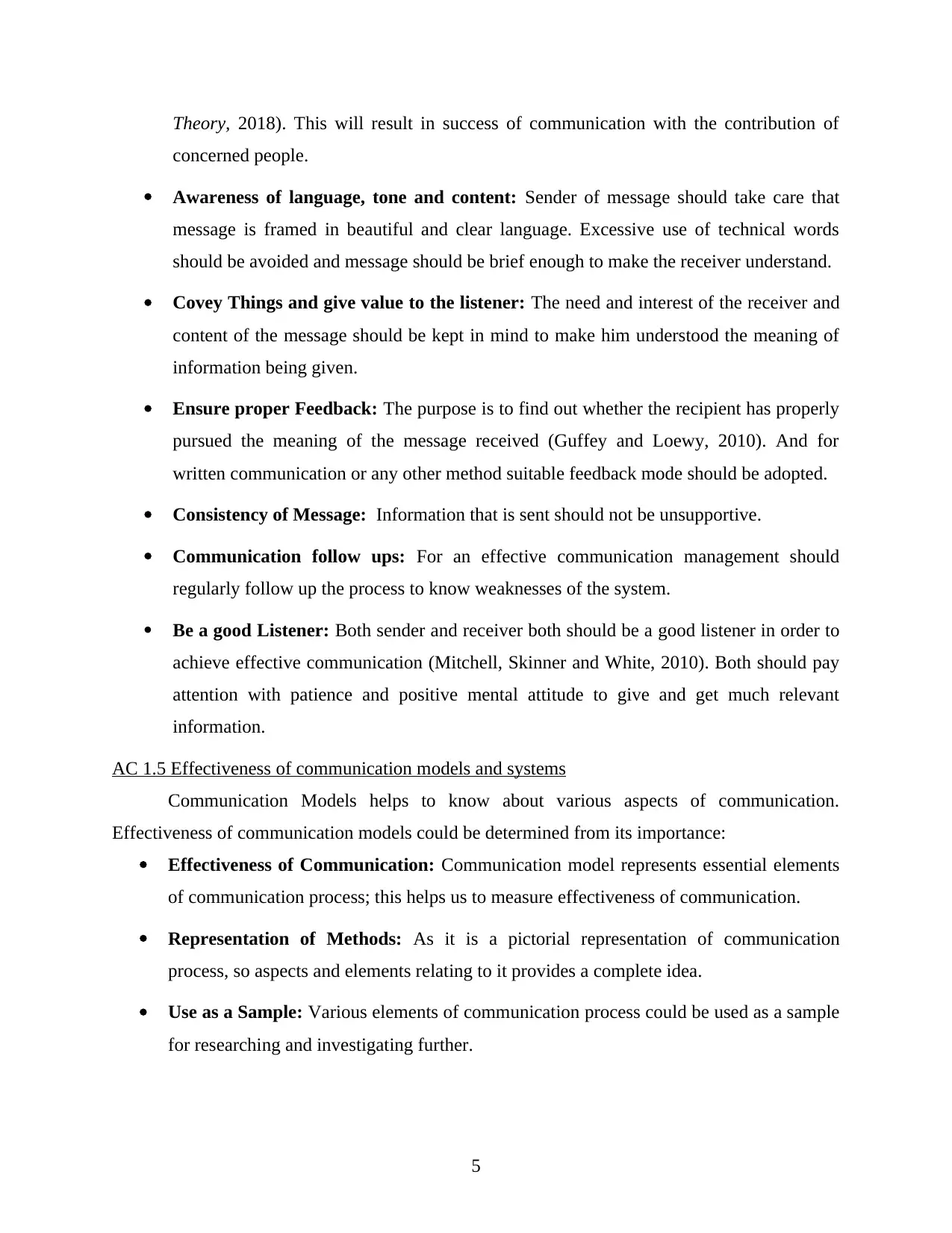
Theory, 2018). This will result in success of communication with the contribution of
concerned people.
Awareness of language, tone and content: Sender of message should take care that
message is framed in beautiful and clear language. Excessive use of technical words
should be avoided and message should be brief enough to make the receiver understand.
Covey Things and give value to the listener: The need and interest of the receiver and
content of the message should be kept in mind to make him understood the meaning of
information being given.
Ensure proper Feedback: The purpose is to find out whether the recipient has properly
pursued the meaning of the message received (Guffey and Loewy, 2010). And for
written communication or any other method suitable feedback mode should be adopted.
Consistency of Message: Information that is sent should not be unsupportive.
Communication follow ups: For an effective communication management should
regularly follow up the process to know weaknesses of the system.
Be a good Listener: Both sender and receiver both should be a good listener in order to
achieve effective communication (Mitchell, Skinner and White, 2010). Both should pay
attention with patience and positive mental attitude to give and get much relevant
information.
AC 1.5 Effectiveness of communication models and systems
Communication Models helps to know about various aspects of communication.
Effectiveness of communication models could be determined from its importance:
Effectiveness of Communication: Communication model represents essential elements
of communication process; this helps us to measure effectiveness of communication.
Representation of Methods: As it is a pictorial representation of communication
process, so aspects and elements relating to it provides a complete idea.
Use as a Sample: Various elements of communication process could be used as a sample
for researching and investigating further.
5
concerned people.
Awareness of language, tone and content: Sender of message should take care that
message is framed in beautiful and clear language. Excessive use of technical words
should be avoided and message should be brief enough to make the receiver understand.
Covey Things and give value to the listener: The need and interest of the receiver and
content of the message should be kept in mind to make him understood the meaning of
information being given.
Ensure proper Feedback: The purpose is to find out whether the recipient has properly
pursued the meaning of the message received (Guffey and Loewy, 2010). And for
written communication or any other method suitable feedback mode should be adopted.
Consistency of Message: Information that is sent should not be unsupportive.
Communication follow ups: For an effective communication management should
regularly follow up the process to know weaknesses of the system.
Be a good Listener: Both sender and receiver both should be a good listener in order to
achieve effective communication (Mitchell, Skinner and White, 2010). Both should pay
attention with patience and positive mental attitude to give and get much relevant
information.
AC 1.5 Effectiveness of communication models and systems
Communication Models helps to know about various aspects of communication.
Effectiveness of communication models could be determined from its importance:
Effectiveness of Communication: Communication model represents essential elements
of communication process; this helps us to measure effectiveness of communication.
Representation of Methods: As it is a pictorial representation of communication
process, so aspects and elements relating to it provides a complete idea.
Use as a Sample: Various elements of communication process could be used as a sample
for researching and investigating further.
5
Paraphrase This Document
Need a fresh take? Get an instant paraphrase of this document with our AI Paraphraser
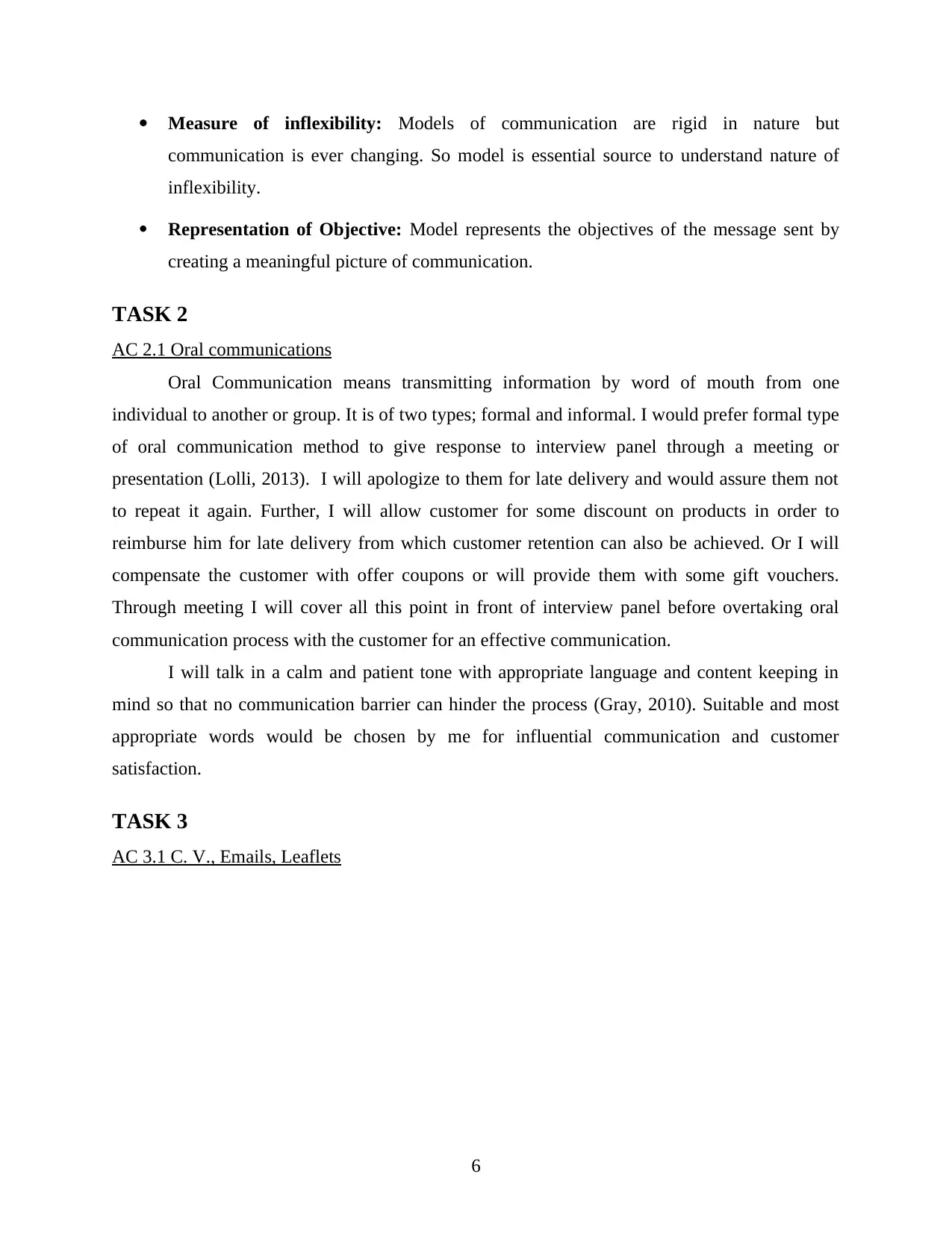
Measure of inflexibility: Models of communication are rigid in nature but
communication is ever changing. So model is essential source to understand nature of
inflexibility.
Representation of Objective: Model represents the objectives of the message sent by
creating a meaningful picture of communication.
TASK 2
AC 2.1 Oral communications
Oral Communication means transmitting information by word of mouth from one
individual to another or group. It is of two types; formal and informal. I would prefer formal type
of oral communication method to give response to interview panel through a meeting or
presentation (Lolli, 2013). I will apologize to them for late delivery and would assure them not
to repeat it again. Further, I will allow customer for some discount on products in order to
reimburse him for late delivery from which customer retention can also be achieved. Or I will
compensate the customer with offer coupons or will provide them with some gift vouchers.
Through meeting I will cover all this point in front of interview panel before overtaking oral
communication process with the customer for an effective communication.
I will talk in a calm and patient tone with appropriate language and content keeping in
mind so that no communication barrier can hinder the process (Gray, 2010). Suitable and most
appropriate words would be chosen by me for influential communication and customer
satisfaction.
TASK 3
AC 3.1 C. V., Emails, Leaflets
6
communication is ever changing. So model is essential source to understand nature of
inflexibility.
Representation of Objective: Model represents the objectives of the message sent by
creating a meaningful picture of communication.
TASK 2
AC 2.1 Oral communications
Oral Communication means transmitting information by word of mouth from one
individual to another or group. It is of two types; formal and informal. I would prefer formal type
of oral communication method to give response to interview panel through a meeting or
presentation (Lolli, 2013). I will apologize to them for late delivery and would assure them not
to repeat it again. Further, I will allow customer for some discount on products in order to
reimburse him for late delivery from which customer retention can also be achieved. Or I will
compensate the customer with offer coupons or will provide them with some gift vouchers.
Through meeting I will cover all this point in front of interview panel before overtaking oral
communication process with the customer for an effective communication.
I will talk in a calm and patient tone with appropriate language and content keeping in
mind so that no communication barrier can hinder the process (Gray, 2010). Suitable and most
appropriate words would be chosen by me for influential communication and customer
satisfaction.
TASK 3
AC 3.1 C. V., Emails, Leaflets
6
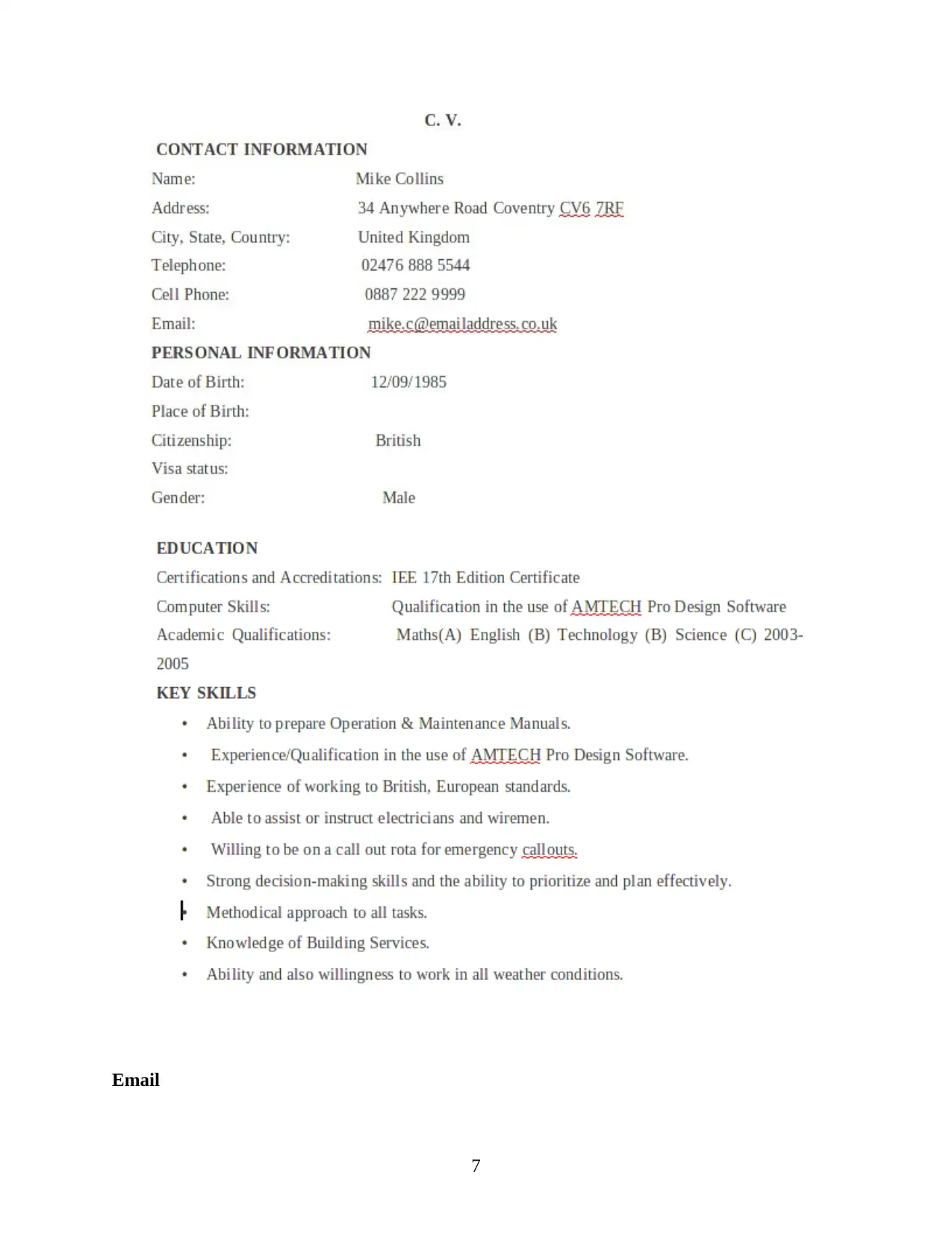
Email
7
7
⊘ This is a preview!⊘
Do you want full access?
Subscribe today to unlock all pages.

Trusted by 1+ million students worldwide
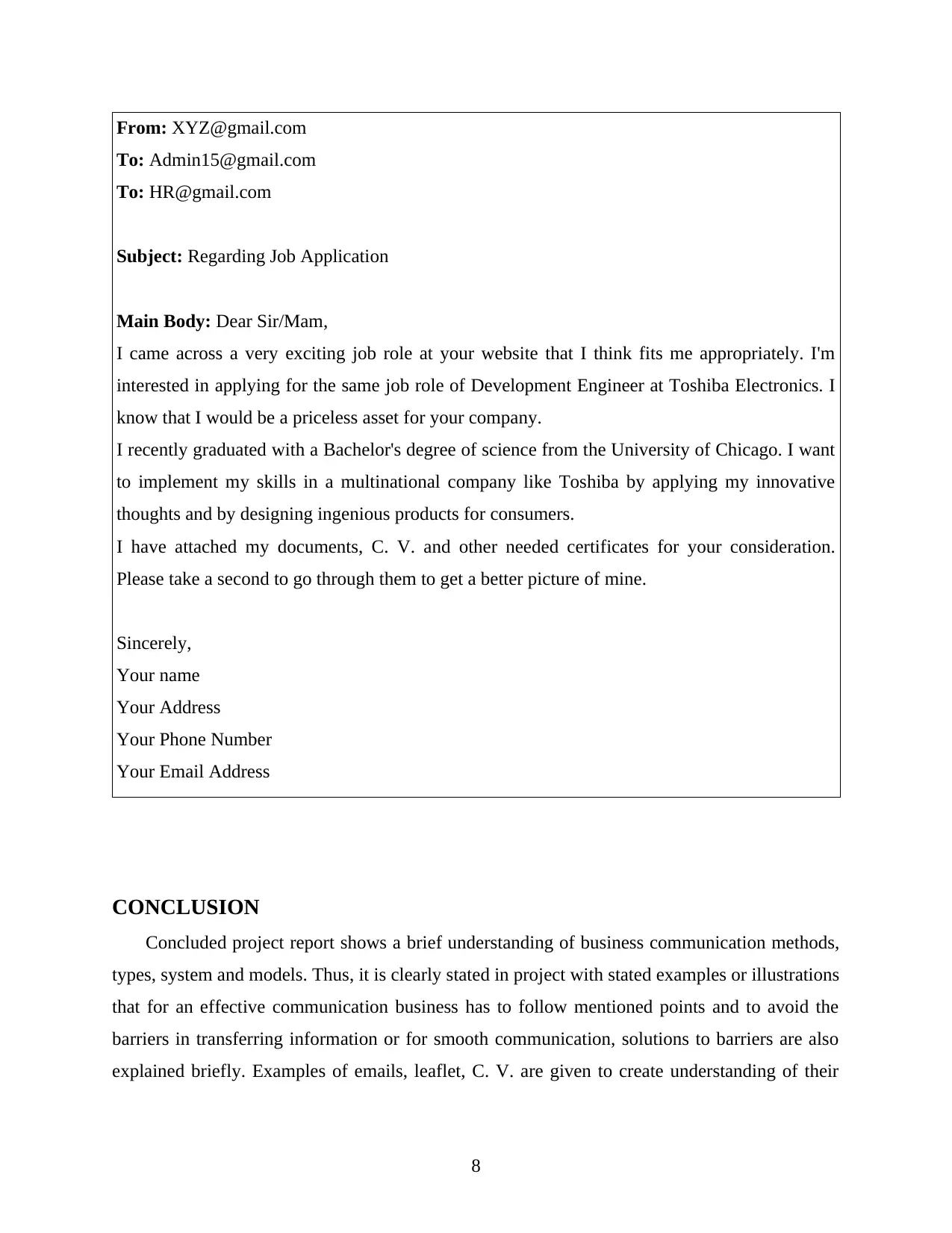
From: XYZ@gmail.com
To: Admin15@gmail.com
To: HR@gmail.com
Subject: Regarding Job Application
Main Body: Dear Sir/Mam,
I came across a very exciting job role at your website that I think fits me appropriately. I'm
interested in applying for the same job role of Development Engineer at Toshiba Electronics. I
know that I would be a priceless asset for your company.
I recently graduated with a Bachelor's degree of science from the University of Chicago. I want
to implement my skills in a multinational company like Toshiba by applying my innovative
thoughts and by designing ingenious products for consumers.
I have attached my documents, C. V. and other needed certificates for your consideration.
Please take a second to go through them to get a better picture of mine.
Sincerely,
Your name
Your Address
Your Phone Number
Your Email Address
CONCLUSION
Concluded project report shows a brief understanding of business communication methods,
types, system and models. Thus, it is clearly stated in project with stated examples or illustrations
that for an effective communication business has to follow mentioned points and to avoid the
barriers in transferring information or for smooth communication, solutions to barriers are also
explained briefly. Examples of emails, leaflet, C. V. are given to create understanding of their
8
To: Admin15@gmail.com
To: HR@gmail.com
Subject: Regarding Job Application
Main Body: Dear Sir/Mam,
I came across a very exciting job role at your website that I think fits me appropriately. I'm
interested in applying for the same job role of Development Engineer at Toshiba Electronics. I
know that I would be a priceless asset for your company.
I recently graduated with a Bachelor's degree of science from the University of Chicago. I want
to implement my skills in a multinational company like Toshiba by applying my innovative
thoughts and by designing ingenious products for consumers.
I have attached my documents, C. V. and other needed certificates for your consideration.
Please take a second to go through them to get a better picture of mine.
Sincerely,
Your name
Your Address
Your Phone Number
Your Email Address
CONCLUSION
Concluded project report shows a brief understanding of business communication methods,
types, system and models. Thus, it is clearly stated in project with stated examples or illustrations
that for an effective communication business has to follow mentioned points and to avoid the
barriers in transferring information or for smooth communication, solutions to barriers are also
explained briefly. Examples of emails, leaflet, C. V. are given to create understanding of their
8
Paraphrase This Document
Need a fresh take? Get an instant paraphrase of this document with our AI Paraphraser
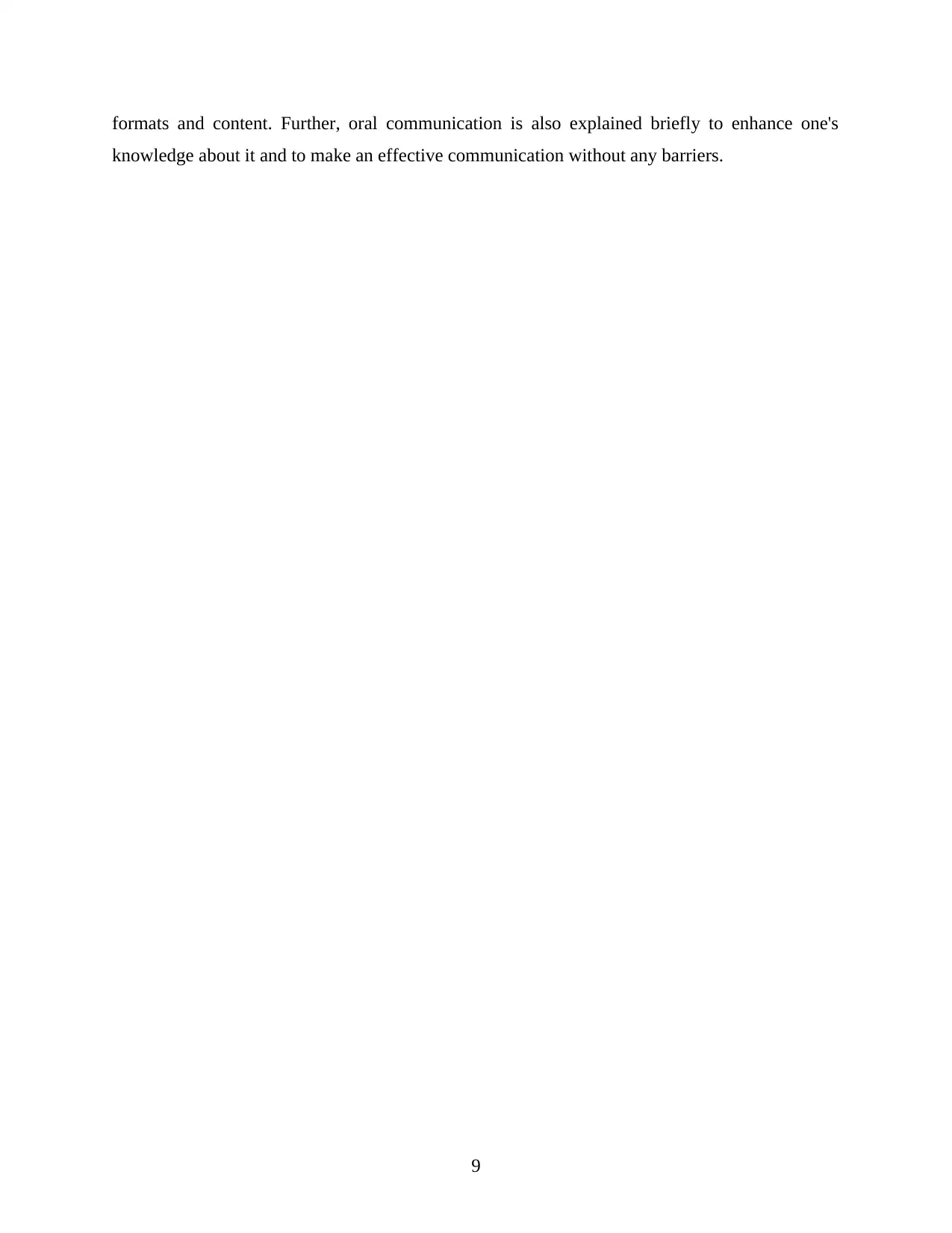
formats and content. Further, oral communication is also explained briefly to enhance one's
knowledge about it and to make an effective communication without any barriers.
9
knowledge about it and to make an effective communication without any barriers.
9
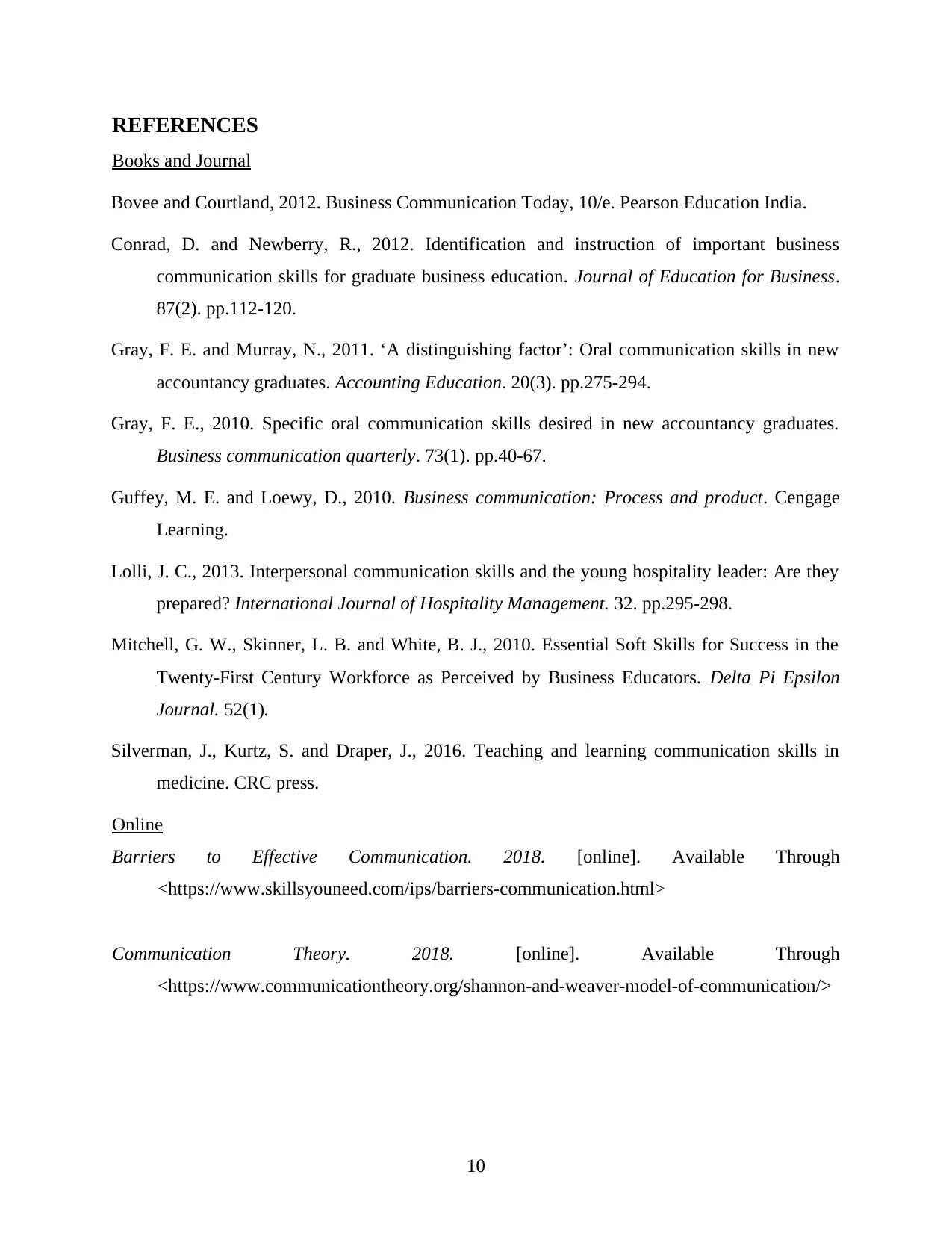
REFERENCES
Books and Journal
Bovee and Courtland, 2012. Business Communication Today, 10/e. Pearson Education India.
Conrad, D. and Newberry, R., 2012. Identification and instruction of important business
communication skills for graduate business education. Journal of Education for Business.
87(2). pp.112-120.
Gray, F. E. and Murray, N., 2011. ‘A distinguishing factor’: Oral communication skills in new
accountancy graduates. Accounting Education. 20(3). pp.275-294.
Gray, F. E., 2010. Specific oral communication skills desired in new accountancy graduates.
Business communication quarterly. 73(1). pp.40-67.
Guffey, M. E. and Loewy, D., 2010. Business communication: Process and product. Cengage
Learning.
Lolli, J. C., 2013. Interpersonal communication skills and the young hospitality leader: Are they
prepared? International Journal of Hospitality Management. 32. pp.295-298.
Mitchell, G. W., Skinner, L. B. and White, B. J., 2010. Essential Soft Skills for Success in the
Twenty-First Century Workforce as Perceived by Business Educators. Delta Pi Epsilon
Journal. 52(1).
Silverman, J., Kurtz, S. and Draper, J., 2016. Teaching and learning communication skills in
medicine. CRC press.
Online
Barriers to Effective Communication. 2018. [online]. Available Through
<https://www.skillsyouneed.com/ips/barriers-communication.html>
Communication Theory. 2018. [online]. Available Through
<https://www.communicationtheory.org/shannon-and-weaver-model-of-communication/>
10
Books and Journal
Bovee and Courtland, 2012. Business Communication Today, 10/e. Pearson Education India.
Conrad, D. and Newberry, R., 2012. Identification and instruction of important business
communication skills for graduate business education. Journal of Education for Business.
87(2). pp.112-120.
Gray, F. E. and Murray, N., 2011. ‘A distinguishing factor’: Oral communication skills in new
accountancy graduates. Accounting Education. 20(3). pp.275-294.
Gray, F. E., 2010. Specific oral communication skills desired in new accountancy graduates.
Business communication quarterly. 73(1). pp.40-67.
Guffey, M. E. and Loewy, D., 2010. Business communication: Process and product. Cengage
Learning.
Lolli, J. C., 2013. Interpersonal communication skills and the young hospitality leader: Are they
prepared? International Journal of Hospitality Management. 32. pp.295-298.
Mitchell, G. W., Skinner, L. B. and White, B. J., 2010. Essential Soft Skills for Success in the
Twenty-First Century Workforce as Perceived by Business Educators. Delta Pi Epsilon
Journal. 52(1).
Silverman, J., Kurtz, S. and Draper, J., 2016. Teaching and learning communication skills in
medicine. CRC press.
Online
Barriers to Effective Communication. 2018. [online]. Available Through
<https://www.skillsyouneed.com/ips/barriers-communication.html>
Communication Theory. 2018. [online]. Available Through
<https://www.communicationtheory.org/shannon-and-weaver-model-of-communication/>
10
⊘ This is a preview!⊘
Do you want full access?
Subscribe today to unlock all pages.

Trusted by 1+ million students worldwide
1 out of 13
Related Documents
Your All-in-One AI-Powered Toolkit for Academic Success.
+13062052269
info@desklib.com
Available 24*7 on WhatsApp / Email
![[object Object]](/_next/static/media/star-bottom.7253800d.svg)
Unlock your academic potential
Copyright © 2020–2025 A2Z Services. All Rights Reserved. Developed and managed by ZUCOL.





